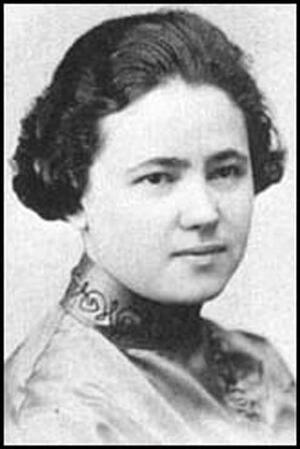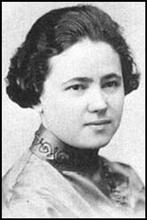Mollie Steimer
Mollie Steimer immigrated from Russia to the United States at age fifteen, worked in a garment factory, and by 1917 had joined Frayhayt, a Jewish radical anarchist group. Because of leaflets distributed protesting America’s intervention in the Russian Revolution, five members of this group were found guilty under the Sedition Act during a widely publicized 1918 trial. Steimer received a sentence of fifteen years. Released on bail, she continued her radical activities and was eventually deported to Russia in 1921. There she was sent to Siberia in 1922 for her activism on behalf of political prisoners. After two hunger strikes, she was deported again to Germany and spent the next fifteen years between Berlin and Paris before fleeing to Mexico at the beginning of World War II.
Early Life and Sedition Trial
Mollie Steimer, a leading anarchist and advocate for the rights of political prisoners, was a codefendant in one of the most publicized antiradical trials in American history.
Born on November 21, 1897, in Dunaevtsy, Russia, Steimer arrived in New York City at age fifteen, along with her father, her mother Fannie Steimer, and five brothers and sisters. To help support her family, she worked in a garment factory, where she was first exposed to radicalism. In 1917, she became an anarchist and joined a group of Jewish radicals calling itself Frayhayt [Liberty]. The group supported the Russian Revolution and, in addition to publishing a Yiddish journal, secretly distributed leaflets and other propaganda materials that were banned by wartime legislation. Among these materials were two brochures—one in English and one in Yiddish—opposing American intervention in the Russian Revolution and strongly criticizing the U.S. Government.
The two brochures soon got Frayhayt in trouble with government authorities. One of the group’s members was arrested for distributing the leaflets. After he agreed to cooperate with military intelligence, six other members, including Steimer, were arrested and charged with conspiring to violate the Sedition Act.
The subsequent trial became a cause célèbre, notable as the first major prosecution under the Sedition Act and for the blatant infringement of the defendants’ rights. Steimer and her codefendants were represented by Harry Weinberger, a well-known advocate for conscientious objectors, pacifists, and radicals. The two-week trial began on October 10, 1918. Weinberger argued that, since the actions of the defendants did not directly interfere with the war effort, they were not punishable under the provisions of the Sedition Act. Despite his defense, all but one of the defendants were found guilty, and four were given major sentences. Jacob Abrams, Hyman Lachowsky, and Samuel Lipman were each sentenced to twenty years in prison and fined one thousand dollars, while Steimer received fifteen years and a fine of five thousand dollars. All four appealed their case to the Supreme Court.
Released on bail, Steimer continued her radical activities. She was befriended by anarchist Emma Goldman, who had just been released from prison herself. Goldman admired Steimer’s uncompromising attitude toward anarchist ideals and called her “a sort of Alexander Berkman in skirts.” Steimer’s continued radical activities resulted in at least eight arrests while her case was on appeal, and finally led to her imprisonment on Blackwell’s Island in the East River toward the end of 1919. While she was there, the Supreme Court upheld her conviction and those of her colleagues. Steimer was transferred to a prison in Jefferson City, Missouri, where she was put to work sewing garments.
Deportation to Russia
Meanwhile, Harry Weinberger continued his efforts to free the four anarchists, this time hoping to obtain a pardon, a decree of amnesty, or deportation to Russia. He was able to elicit a groundswell of support for the group, not only among Jewish radicals but also among a number of leading lawyers and intellectuals who were convinced that they had not received a fair trial. Despite such support, Steimer refused to sign a petition for amnesty or to request deportation to Russia. “I do not want any pardon,” she wrote to Weinberger. “The word ‘pardon’ drills my ears and affects my sense of right, which is bad already.” She objected to deportation on the basis of her belief that “each person shall live where he or she chooses,” and that “No individual has the right to send me out of this, or of any country!” Despite these objections, Weinberger secured the group’s release. In 1921, the four anarchists were permitted to be deported to Soviet Russia at their own expense, and received a full pardon on the condition that they never return to the United States.
After arriving in Russia, Steimer was disappointed to find that anarchists were little more welcome than in the United States. Goldman and Berkman, who had been deported a few months before her, had already left the country in disillusionment. The new communist regime tolerated no opposition to state policy and viewed the anarchists as a threat to its authority. Promising to “advocate my ideal, anarchist communism, in whatever country I shall be,” Steimer started spreading propaganda for anarchist causes and on behalf of Soviet political prisoners.
Not long after her arrival in Russia, Steimer met and fell in love with fellow anarchist Senya Fleshin, a Russian-born Jew who had immigrated to the United States and returned after the Revolution. Although the two never married, they became devoted companions. Like Steimer, Fleshin was disillusioned with the Soviet regime, and the two joined forces in their work to help political prisoners. In 1922, Steimer and Fleshin were arrested by the Soviet secret police, accused of having anarchist connections in Europe and the United States. They were sentenced to two years’ exile in Siberia, but were released when they staged a hunger strike. After being arrested a second time and staging another hunger strike, the two were expelled from the Soviet Union, leaving for Germany in 1923.
Later Life and Activism
During the next fifteen years, Steimer and Fleshin moved between Berlin and Paris, aiding political prisoners and anarchist exiles. They maintained contacts with countless prisoners—to whom they sent care packages—and with radicals in several countries, many of whom they received as guests. The couple also took part in the major debates of the day concerning radical politics, including the controversy surrounding Peter Arshinov’s Organizational Platform. Arshinov proposed the creation of a central executive committee to guide the anarchist movement, a move that Steimer and Fleshin felt would lead to authoritarianism and a subversion of anarchist principles.
At the beginning of World War II, Steimer and Fleshin were living in Paris. With the invasion of France by the Germans they faced danger both as radicals and Jews. In 1940, Steimer was arrested and taken to an internment camp, while Fleshin fled to the unoccupied sector. Able to negotiate her release, Steimer was reunited with Fleshin in Marseilles, and the two fled to Mexico City, where they opened a photographic studio and became part of a growing group of political exiles. In 1963, they retired to the town of Cuernavaca. Steimer spent her final years corresponding with fellow radicals and receiving many visitors who admired her as a veteran of the international anarchist movement. She died on July 23, 1980, at age eighty-two.
Avrich, Paul. Anarchist Portraits (1988); Szajkowski, Zosa. “Double Jeopardy—
The Abrams Case of 1919.” American Jewish Archives 23 (April 1971): 8–32.




